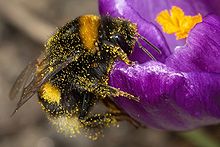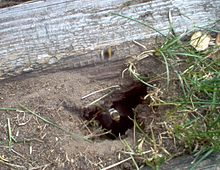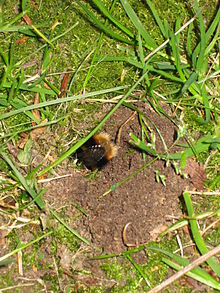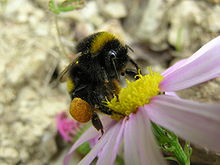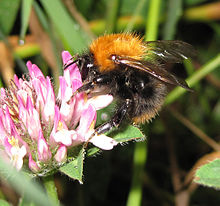- Bumble bee
-
For other uses, see Bumblebee (disambiguation) and Bombus (disambiguation).
Bombus 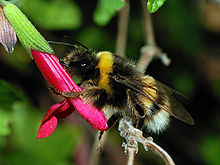
Bombus terrestris Scientific classification Kingdom: Animalia Phylum: Arthropoda Class: Insecta Order: Hymenoptera Family: Apidae Subfamily: Apinae Tribe: Bombini Genus: Bombus
Latreille, 1802Species A bumble bee (also written as bumblebee) is any member of the bee genus Bombus, in the family Apidae. There are over 250 known species, existing primarily in the Northern Hemisphere although they are common in New Zealand and in the Australian state of Tasmania.
Bumble bees are social insects that are characterised by black and yellow body hairs, often in bands. However, some species have orange or red on their bodies, or may be entirely black.[1] Another obvious (but not unique) characteristic is the soft nature of the hair (long, branched setae), called pile, that covers their entire body, making them appear and feel fuzzy. They are best distinguished from similarly large, fuzzy bees by the form of the female hind leg, which is modified to form a corbicula: a shiny concave surface that is bare, but surrounded by a fringe of hairs used to transport pollen (in similar bees, the hind leg is completely hairy, and pollen grains are wedged into the hairs for transport).
Like their relatives the honey bees, bumble bees feed on nectar and gather pollen to feed their young.
Contents
Biology
The blood or hemolymph, as in other arthropods, is carried in an open circulatory system.[2] The body organs, "heart" (dorsal aorta), muscles, etc. are surrounded in a reservoir of blood. The dorsal aorta does pulse blood through its long tube, though, so there is a circulation of sorts.
In fertilised queens the ovaries are activated when the queen lays her egg. It passes along the oviduct to the vagina. In the vagina there is a container called the spermatheca. This is where the queen stores sperm from her mating. Before she lays the egg, she will decide whether to use sperm from the spermatheca to fertilise it or not. Non-fertilised eggs grow into males, and only fertilised eggs grow into females and queens.
As in all animals, hormones play a big role in the growth and development of the bumble bee. The hormones that stimulate the development of the ovaries are suppressed in the other female worker bees while the queen remains dominant. Salivary glands in the head secrete saliva, which mixes with the nectar and pollen. Saliva is also mixed into the nest materials to soften them. The fat body is a nutritional store; before hibernation, queens eat as much as they can to enlarge their fat body, and the fat in the cells is used up during hibernation.
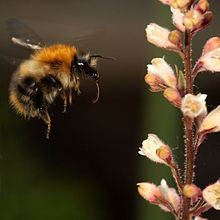 A bumble bee extending its tongue towards a Heuchera inflorescence
A bumble bee extending its tongue towards a Heuchera inflorescence
Like all bee tongues, the bumblebee tongue (the proboscis) is a long hairy structure that extends from a sheath-like modified maxilla. The primary action of the tongue is lapping, i.e. repeated dipping of the tongue into liquid.[3] During lapping, nectar is drawn up the proboscis by capillary action. When at rest or flying, the proboscis is kept folded under the head. The abdomen is divided into dorsal tergites and ventral sternites. Wax is secreted from glands on the sternites.
The brightly coloured pile of the bumble bee is a form of aposematic signal. Depending on the species and morph, these colours can range from entirely black, to bright yellow, red, orange, white, and pink. Thick pile can also act as insulation to keep the bee warm in cold weather. Further, when flying a bee builds up an electrostatic charge, and as flowers are usually well grounded, pollen is attracted to the bee's pile when it lands. When a pollen-covered bee enters a flower, the charged pollen is preferentially attracted to the stigma because it is better grounded than the other parts of the flower.
Bumble bees do not have ears; however, they can feel the vibrations of sounds through wood and other materials.
Habitat
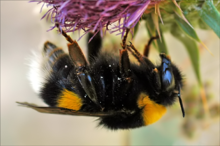 Bombus polaris, a polar bumble bee
Bombus polaris, a polar bumble bee
Bumble bees are typically found in higher latitudes and/or high altitudes, though exceptions exist (there are a few lowland tropical species).[4] A few species (Bombus polaris and B. alpinus) range into very cold climates where other bees might not be found; B. polaris can be found in northern Ellesmere Island—the northernmost occurrence of any eusocial insect—along with its parasite, B. hyperboreus.[5] One reason for this is that bumble bees can regulate their body temperature, via solar radiation, internal mechanisms of "shivering" and radiative cooling from the abdomen (called heterothermy). Other bees have similar physiology, but the mechanisms have been best studied in bumble bees.[6]
Nests
Bumble bees form colonies, which are usually much less extensive than those of honey bees. This is due to a number of factors including the small physical size of the nest cavity, the responsibility of a single female for the initial construction and reproduction that happens within the nest, and the restriction of the colony to a single season (in most species). Often, mature bumble bee nests will hold fewer than 50 individuals. Bumble bee nests may be found within tunnels in the ground made by other animals, or in tussock grass as opposed to Carpenter Bees that burrow into wood. Bumble bees sometimes construct a wax canopy ("involucrum") over the top of their nest for protection and insulation. Bumble bees do not often preserve their nests through the winter, though some tropical species live in their nests for several years (and their colonies can grow quite large, depending on the size of the nest cavity). In temperate species, the last generation of summer includes a number of queens who overwinter separately in protected spots. The queens can live up to one year, possibly longer in tropical species.
Colony cycle
Bumble bee nests are first constructed by over-wintered queens in the spring (in temperate areas). Upon emerging from hibernation, the queen collects pollen and nectar from flowers and searches for a suitable nest site. The characteristics of the nest site vary among bumble bee species, with some species preferring to nest in underground holes and others in tussock grass or directly on the ground. Once the queen finds a site, she prepares wax pots to store food, and wax cells to lay eggs in. These eggs then hatch into larvae, which cause the wax cells to expand isometrically into a clump of brood cells.
To develop, these larvae must be fed both nectar for carbohydrates and pollen for protein. Bumble bees feed nectar to the larvae by chewing a small hole in the brood cell into which they regurgitate nectar. Larvae are fed pollen in one of two ways, depending on the bumble bee species. So-called "pocket-maker" bumble bees create pockets of pollen at the base of the brood-cell clump that the larvae feed themselves from. Conversely, "pollen-storers" store pollen in separate wax pots and feed it to the larvae in the same fashion as nectar.[7] Bumble bees are incapable of trophallaxis (direct transfer of food from one bee to another).
With proper care, the larvae progress through four instars, becoming successively larger with each moult. At the end of the fourth instar, the larvae spin silk cocoons under the wax covering the brood cells, changing them into pupal cells. The larvae then undergo an intense period of cellular growth and differentiation and become pupae. These pupae then develop into adult bees, and chew their way out of the silk cocoon. When adult bumble bees first emerge from their cocoons, the hairs on their body are not yet fully pigmented and are a greyish-white colour. The bees are referred to as "callow" during this time, and they will not leave the colony for at least 24 hours. The entire process from egg to adult bee can take as long as five weeks, depending on the species and the environmental conditions.
After the emergence of the first or second group of workers, workers take over the task of foraging and the queen spends most of her time laying eggs and caring for larvae. The colony grows progressively larger and at some point will begin to produce males and new queens. The point at which this occurs varies among species and is heavily dependent on resource availability and environmental factors. Unlike the workers of more advanced social insects, bumble bee workers are not physically reproductively sterile and are able to lay haploid eggs that develop into viable male bumble bees. Only fertilised queens can lay diploid eggs that mature into workers and new queens.
Early in the colony cycle, the queen bumble bee compensates for potential reproductive competition from workers by suppressing their egg-laying by way of physical aggression and pheromonal signals.[8] Thus, the queen will usually be the mother of all of the first males laid. Workers eventually begin to lay male eggs later in the season when the queen's ability to suppress their reproduction diminishes.[9] The reproductive competition between workers and the queen is one reason that bumble bees are considered "primitively eusocial".
New queens and males leave the colony after maturation. Males in particular are forcibly driven out by the workers. Away from the colony, the new queens and males live off nectar and pollen and spend the night on flowers or in holes. The queens are eventually mated (often more than once) and search for a suitable location for diapause (dormancy).
Foraging behaviour
Further information: Bumblebee communicationBumble bees generally visit flowers exhibiting the bee pollination syndrome. They can visit patches of flowers up to 1–2 kilometres from their colony.[10] Bumble bees will also tend to visit the same patches of flowers every day, as long as they continue to find nectar and pollen,[11] a habit known as pollinator or flower constancy. While foraging, bumblebees can reach ground speeds of up to 15 metres per second (54 km/h).[12]
Experiments have shown that bumble bees are able to use a combination of colour and spatial relationships in learning which flowers to forage from.[13] After arriving at a flower, they extract nectar using their long tongue ("glossa") and store it in their crop. Many species of bumble bee also exhibit what is known as "nectar robbing": instead of inserting the mouthparts into the flower normally, these bees bite directly through the base of the corolla to extract nectar, avoiding pollen transfer.[14] These bees obtain pollen from other species of flowers that they “legitimately” visit.
Pollen is removed from flowers deliberately or incidentally by bumble bees. Incidental removal occurs when bumble bees come in contact with the anthers of a flower while collecting nectar. The bumble bee's body hairs receive a dusting of pollen from the anthers, which is then groomed into the corbicula ("pollen basket"). Bumblebees are also capable of buzz pollination.
In at least a few species, once a bumble bee has visited a flower, it leaves a scent mark on the flower. This scent mark deters visitation of the flower by other bumble bees until the scent degrades.[15] It has been shown that this scent mark is a general chemical bouquet that bumblebees leave behind in different locations (e.g. nest, neutral, and food sites),[16] and they learn to use this bouquet to identify both rewarding and unrewarding flowers.[17] In addition, bumble bees rely on this chemical bouquet more when the flower has a high handling time (i.e. it takes a longer time for the bee to find the nectar).[18]
Once they have collected nectar and pollen, bumble bees return to the nest and deposit the harvested nectar and pollen into brood cells, or into wax cells for storage. Unlike honey bees, bumble bees only store a few days' worth of food and so are much more vulnerable to food shortages.[19]
Cuckoo bumblebees
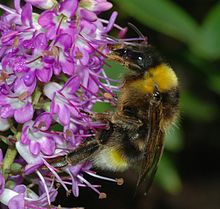 The cuckoo bumble bee Bombus vestalis, a parasite of Bombus terrestris
The cuckoo bumble bee Bombus vestalis, a parasite of Bombus terrestris
Bumble bees of the subgenus Psithyrus (known as cuckoo bumble bees, and formerly considered a separate genus) are a lineage that live parasitically in the colonies of other bumble bees and have lost the ability to collect pollen. Before finding and invading a host colony, a Psithyrus female (there is no caste system in these species) will feed directly from flowers. Once she has infiltrated a host colony, the Psithyrus female will kill or subdue the queen of that colony and forcibly (using pheromones and/or physical attacks) "enslave" the workers of that colony to feed her and her young.[20] The female Psithyrus also has a number of morphological adaptations, such as larger mandibles and a larger venom sac that increase her chances of taking over a nest.[21] Upon hatching, the male and female Psithyrus disperse and mate. Like non-parasitic bumble bee queens, female Psithyrus find suitable locations to spend the winter and enter diapause upon being mated.
Reproduction
In temperate zone species, in the autumn, young queens ("gynes") mate with males (drones) and diapause during the winter in a sheltered area, whether in the ground or in a man-made structure. In the early spring, the queen comes out of diapause and finds a suitable place to create her colony. Then she builds wax cells in which to lay her fertilised eggs from the previous winter. The eggs that hatch develop into female workers, and in time the queen populates the colony, with workers feeding the young and performing other duties similar to honey bee workers. New reproductives are produced in autumn, and the queen and workers die, as do the males.
Sting
Queen and worker bumble bees can sting. Unlike a honey bee's stinger a bumble bee's stinger lacks barbs, so they can sting more than once.[22][23] Bumblebee species are not normally aggressive, but will sting in defence of their nest, or if harmed. Female cuckoo bumble bees will aggressively attack host colony members, and sting the host queen, but will ignore other animals and humans unless disturbed.
Bumble bees and people
Bumble bees are important pollinators of both crops and wildflowers.
Comments by Charles Darwin
In his first (1859) edition of On the Origin of Species,[24] Charles Darwin wrote of "humble-bees" (a now-disused term for bumble bees; see the etymology section below in this article for more information) and their interactions with other species:
plants and animals, most remote in the scale of nature, are bound together by a web of complex relations. [...] I have [...] reason to believe that humble-bees are indispensable to the fertilisation of the heartsease (Viola tricolor), for other bees do not visit this flower. From experiments which I have tried, I have found that the visits of bees, if not indispensable, are at least highly beneficial to the fertilisation of our clovers; but humble-bees alone visit the common red clover (Trifolium pratense), as other bees cannot reach the nectar. Hence I have very little doubt, that if the whole genus of humble-bees became extinct or very rare in England, the heartsease and red clover would become very rare, or wholly disappear. The number of humble-bees in any district depends in a great degree on the number of field-mice, which destroy their combs and nests; and Mr. H. Newman, who has long attended to the habits of humble-bees, believes that 'more than two thirds of them are thus destroyed all over England.' Now the number of mice is largely dependent, as every one knows, on the number of cats; and Mr. Newman says, 'Near villages and small towns I have found the nests of humble-bees more numerous than elsewhere, which I attribute to the number of cats that destroy the mice.' Hence it is quite credible that the presence of a feline animal in large numbers in a district might determine, through the intervention first of mice and then of bees, the frequency of certain flowers in that district!
Agricultural use
Main article: List of crop plants pollinated by beesBumble bees are increasingly cultured for agricultural use as pollinators because they can pollinate plant species that other pollinators cannot by using a technique known as buzz pollination. For example, bumble bee colonies are often placed in greenhouse tomato production, because the frequency of buzzing that a bumble bee exhibits effectively releases tomato pollen.[25]
The agricultural use of bumble bees is limited to pollination. Because bumble bees do not overwinter the entire colony, they are not obliged to stockpile honey, and are therefore not useful as honey producers.
Endangered status
Bumble bees are in danger in many developed countries due to habitat destruction and collateral pesticide damage. In Britain, until relatively recently, 19 species of native true bumble bee were recognised along with six species of cuckoo bumble bees. Of these, three have been extirpated,[26][27] eight are in serious decline, and only six remain widespread.[28] Similar declines in bumble bees have been reported in Ireland, with 4 species being designated endangered, and another two species considered vulnerable to extinction.[29] A decline in bumble bee numbers could cause large-scale changes to the countryside, leading to inadequate pollination of certain plants. The world's first bumble bee sanctuary was established at Vane Farm in the Loch Leven National Nature Reserve in Scotland in 2008.[30]
Some bumble bees native to North America are also vanishing, such as Bombus terricola, Bombus affinis and Bombus occidentalis, with one, Bombus franklini, that may even be extinct.[31]
Myths
Flight
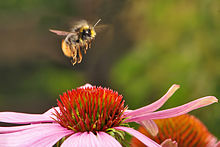 Bombus pratorum over an Echinacea purpurea inflorescence; a widely believed falsehood holds that bumblebees should be incapable of flight.
Bombus pratorum over an Echinacea purpurea inflorescence; a widely believed falsehood holds that bumblebees should be incapable of flight.
According to 20th century folklore, the laws of aerodynamics prove that the bumble bee should be incapable of flight, as it does not have the capacity (in terms of wing size or beats per second) to achieve flight with the degree of wing loading necessary. The origin of this claim has been difficult to pin down with any certainty. John McMasters recounted an anecdote about an unnamed Swiss aerodynamicist at a dinner party who performed some rough calculations and concluded, presumably in jest, that according to the equations, bumble bees cannot fly.[32] In later years McMasters has backed away from this origin, suggesting that there could be multiple sources, and that the earliest he has found was a reference in the 1934 French book Le vol des insectes; they had applied the equations of air resistance to insects and found that their flight was impossible, but that "One shouldn't be surprised that the results of the calculations don't square with reality".[33]
Some credit physicist Ludwig Prandtl (1875–1953) of the University of Göttingen in Germany with popularizing the idea. Others say it was Swiss gas dynamicist Jacob Ackeret (1898–1981) who did the calculations.
In 1934, French entomologist Antoine Magnan included the following passage in the introduction to his book Le Vol des Insectes:
Tout d'abord poussé par ce qui se fait en aviation, j'ai appliqué aux insectes les lois de la résistance de l'air, et je suis arrivé avec M. Sainte-Laguë à cette conclusion que leur vol est impossible.
This translates to:
First prompted by what is done in aviation, I applied the laws of air resistance to insects, and I arrived, with Mr. Sainte-Laguë, at this conclusion that their flight is impossible.
Magnan refers to his assistant André Sainte-Laguë, a mathematician.
The calculations that purported to show that bumble bees cannot fly are based upon a simplified linear treatment of oscillating aerofoils. The method assumes small amplitude oscillations without flow separation. This ignores the effect of dynamic stall, an airflow separation inducing a large vortex above the wing, which briefly produces several times the lift of the aerofoil in regular flight. More sophisticated aerodynamic analysis shows that the bumblebee can fly because its wings encounter dynamic stall in every oscillation cycle.[34]
Additionally, John Maynard Smith, a noted biologist with a strong background in aeronautics, has pointed out that bumble bees would not be expected to sustain flight, as they would need to generate too much power given their tiny wing area. However, in aerodynamics experiments with other insects he found that viscosity at the scale of small insects meant that even their small wings can move a very large volume of air relative to the size, and this reduces the power required to sustain flight by an order of magnitude.[35]
Another description of a bee's wing function is that the wings work similarly to helicopter blades, "reverse-pitch semirotary helicopter blades".
Bees beat their wings approximately 200 times a second. Their thorax muscles do not expand and contract on each nerve firing but rather vibrate like a plucked rubber band.
Buzz
One common, yet incorrect, assumption is that the buzzing sound (
 listen (help·info)) of bees is caused by the beating of their wings. The sound is actually the result of the bee vibrating its flight muscles, and this can be achieved while the muscles are decoupled from the wings. This is especially pronounced in bumblebees, as they must warm up their bodies considerably to get airborne at low ambient temperatures.[6] Bumble bees have been known to reach an internal thoracic temperature of 30 °C (86 °F) using this method.
listen (help·info)) of bees is caused by the beating of their wings. The sound is actually the result of the bee vibrating its flight muscles, and this can be achieved while the muscles are decoupled from the wings. This is especially pronounced in bumblebees, as they must warm up their bodies considerably to get airborne at low ambient temperatures.[6] Bumble bees have been known to reach an internal thoracic temperature of 30 °C (86 °F) using this method.Selected species
For a complete list, see List of world bumblebee species.
- Bombus fraternus
- New garden bumble bee, Bombus hypnorum
- Early bumblebee, Bombus pratorum
- Orange-belted bumble bee Bombus ternarius
- Buff-tailed bumble bee, or large earth bumblebee, Bombus terrestris
Associated parasites
- Tracheal mites – Locustacarus buchneri
- Protozoans – Crithidia bombi
- Microsporidia – Nosema bombi
Etymology
According to the Oxford English Dictionary (OED), the term bumble bee was first recorded as having been used in the English language in the 1530 work Lesclarcissement by John Palsgrave, "I bomme, as a bombyll bee dothe."[36] However the OED also states that the term humble bee predates it, having first been used in 1450 in Fysshynge wyth Angle, "In Juyll the greshop & the humbylbee in the medow."[37] The latter term was used in A Midsummer Night's Dream (circa 1600) by William Shakespeare, "The honie-bags steale from the humble Bees."[38] In the period prior to World War I the preferred English common name was humble bee, as found in On the Origin of Species (1859) by Charles Darwin (see above in this article for a lengthy quotation), though bumble bee was still in use as well, for example in The Tale of Mrs. Tittlemouse (1910) by Beatrix Potter, "Suddenly round a corner, she met Babbitty Bumble--"Zizz, Bizz, Bizzz!" said the bumble bee." In the post-World War II era however, humble bee has fallen into near-total disuse.[39]
Cultural references
The orchestral interlude "Flight of the Bumblebee" was composed (circa 1900) by Nikolai Rimsky-Korsakov to represent the turning of Prince Guidon to visit his father, Tsar Saltan, in the opera The Tale of Tsar Saltan,[40] although the music is considered to more accurately reflect the flight of a bluebottle than a bumblebee.[41] The music inspired Walt Disney to feature a bumble bee in his 1940 animated musical Fantasia and have it sound as if it were flying in all parts of the theater. This early attempt at "surround sound" was unsuccessful, and the music was excluded from the film's release.[42]
The archaic English colloquialism dumbledor (also used for cockchafers)[43] is the source of the name Albus Dumbledore, a fictional character from the Harry Potter series (1997-2007). J.K. Rowling said the name "seemed to suit the headmaster, because one of his passions is music and I imagined him walking around humming to himself".[44]
The generic epithet Bombus, assigned by Pierre André Latreille in 1802, is derived from the Latin word for a buzzing or humming sound.[45]
See also
- Apiology
- Bees
- Characteristics of common wasps and bees
- Imidacloprid effects on bee population
- List of world bumblebee species
- Regent (insecticide)
- Volucella bombylans, a hoverfly mimic of bumble bees
- Bumblebee Orchid
References
- ^ P. H. Williams (2007). "The distribution of bumblebee colour patterns world-wide: possible significance for thermoregulation, crypsis, and warning mimicry". Biological Journal of the Linnean Society 92 (1): 97–118. doi:10.1111/j.1095-8312.2007.00878.x. http://www.nhm.ac.uk/research-curation/projects/bombus/colour.html. Retrieved July 9, 2007.
- ^ "The Rusty-Patched Bumble Bee" Bio Web - Retrieved 13 February 2011.
- ^ Harder L.D. (1986). "Effects of nectar concentration and flower depth on flower handling efficiency of bumble bees". Oecologia 69: 309–315. doi:10.1007/BF00377639.
- ^ "Map at: Bumblebees of the world". Natural History Museum. http://www.nhm.ac.uk/research-curation/projects/bombus/introduction.html. Retrieved July 9, 2007.
- ^ H. E. Milliron & D. R. Oliver (1966). "Bumblebees from northern Ellesmere Island, with observations on usurpation by Megabombus hyperboreus (Schönh.)". Canadian Entomologist 98 (2): 207–213. doi:10.4039/Ent98207-2.
- ^ a b B. Heinrich (1981). Insect Thermoregulation. Krieger Publishing Company. ISBN 0471051446.
- ^ Elaine Evans, Ian Burns & Marla Spivak (2007). Befriending Bumble Bees. St. Paul: University of Minnesota Press.
- ^ C. G. J. Van Honk, H. H. W. Velthuis, P.-F. Röseler & M. E. Malotaux (1980). "The mandibular glands of Bombus terrestris queens as a source of queen pheromones". Entomologia Experimentalis et Applicata 28 (2): 191–198. doi:10.1007/BF00287128.
- ^ D. J. C. Fletcher & K. Ross (1985). "Regulation of reproduction in eusocial Hymenoptera". Annual Reviews in Entomology 30: 319–343. doi:10.1146/annurev.en.30.010185.001535.
- ^ K. Walther-Hellwig & R. Frankl (2000). "Foraging distances of Bombus muscorum, Bombus lapidarius, and Bombus terrestris (Hymenoptera, Apidae)". Journal of Insect Behavior 13 (2): 239–246. doi:10.1023/A:1007740315207.
- ^ W. E. Dramstad, G. L. A. Fry & M. J. Schaffer (2003). "Bumblebee foraging—is closer really better?". Agriculture, Ecosystems and Environment 95 (1): 349–357. doi:10.1016/S0167-8809(02)00043-9.
- ^ J. L. Osborne, S. J. Clark, R. J. Morris, I. H. Williams, J. R. Riley, A. D. Smith, D. R. Reynolds & A. S. Edwards (1999). "A landscape-scale study of bumble bee foraging range and constancy, using harmonic radar". Journal of Applied Ecology 36 (4): 519–533. doi:10.1046/j.1365-2664.1999.00428.x.
- ^ P. S. Blackawton; S. Airzee; A. Allen; S. Baker; A. Berrow; C. Blair; M. Churchill; J. Coles; R. F.-J. Cumming, L. Fraquelli, C. Hackford, A. Hinton Mellor, M. Hutchcroft, B. Ireland, D. Jewsbury, A. Littlejohns, G. M. Littlejohns, M. Lotto, J. McKeown, A. O'Toole, H. Richards, L. Robbins-Davey, S. Roblyn, H. Rodwell-Lynn, D. Schenck, J. Springer, A. Wishy, T. Rodwell-Lynn, D. Strudwick, and R. B. Lotto (2010). "Blackawton bees". Biology Letters 7 (2): 168–72. doi:10.1098/rsbl.2010.1056. PMC 3061190. PMID 21177694. http://rsbl.royalsocietypublishing.org/content/early/2010/12/18/rsbl.2010.1056. Retrieved 5 January 2011.
- ^ J. E. Maloof (2001). "The effects of a bumble bee nectar robber on plant reproductive success and pollinator behavior". American Journal of Botany (American Journal of Botany, Vol. 88, No. 11) 88 (11): 1960–1965. doi:10.2307/3558423. JSTOR 3558423. http://www.amjbot.org/cgi/content/abstract/88/11/1960.
- ^ Dave Goulson, Sadie A. Hawson & Jane C. Stout (1998). "Foraging bumblebees avoid flowers already visited by conspecifics or by other bumblebee species". Animal Behaviour 55 (1): 199–206. doi:10.1006/anbe.1997.0570. PMID 9480686.
- ^ Nehal Saleh, Alan G. Scott, Gareth P. Bryning & Lars Chittka (2007). "Bumblebees use incidental footprints to generate adaptive behaviour at flowers and nest". Arthropod Plant Interactions 1 (2): 119–127. doi:10.1007/s11829-007-9011-6.
- ^ Nehal Saleh & Lars Chittka (2006). "The importance of experience in the interpretation of conspecific chemical signals". Behavioral Ecology and Sociobiology 61 (2): 215–220. doi:10.1007/s00265-006-0252-7.
- ^ Nehal Saleh, Kazuharu Ohashi, James D. Thomson & Lars Chittka (2006). "Facultative use of repellent scent mark in foraging bumblebees: complex versus simple flowers". Animal Behaviour 71 (4): 847–854. doi:10.1016/j.anbehav.2005.06.014.
- ^ Livio Comba & Sarah Corbet. "Living larders for bumblebees". Natural History Museum. http://www.nhm.ac.uk/nature-online/life/plants-fungi/postcode-plants/article.html. Retrieved June 20, 2010.
- ^ B. O. Zimma, M. Ayasse, J. Tengo, F. Ibarra, C. Schulz & W. Francke (2003). "Do social parasitic bumblebees use chemical weapons? (Hymenoptera, Apidae)". Journal of Comparative Physiology A – Neuroethology Sensory Neural and Behavioral Physiology 189 (10): 769–775. doi:10.1007/s00359-003-0451-x. PMID 12955437.
- ^ R. M. Fisher & B. J. Sampson (1992). "Morphological specializations of the bumble bee social parasite Psithyrus ashtoni (Cresson) (Hymenoptera, Apidae)". Canadian Entomologist 124 (1): 69–77. doi:10.4039/Ent12469-1.
- ^ "Do bumblebees sting? Once or many times?". Straight Dope. Archived from the original on December 30, 2007. http://web.archive.org/web/20071230082748/http://www.straightdope.com/mailbag/mbeesting.htm. Retrieved July 9, 2007.
- ^ http://beespotter.mste.illinois.edu/topics/stings/
- ^ http://www.gutenberg.org/ebooks/1228
- ^ "NRDC: OnEarth Magazine, Summer 2006 - The Vanishing". http://www.nrdc.org/OnEarth/06sum/bees3.asp. Retrieved July 9, 2007.
- ^ University of Newcastle-upon-Tyne (July 28, 2006). "Scientists map the flight of the bumblebee". Science Daily. http://www.sciencedaily.com/releases/2006/07/060728162546.htm.
- ^ Alan Harman (July 2003). "Bumblebee Shortage". Bee Culture 59.
- ^ P. H. Williams (1986). "Environmental change and the distributions of British bumble bees (Bombus Latr.)". Bee World 67: 50–61. http://www.nhm.ac.uk/research-curation/projects/bombus/decline.html.
- ^ U. Fitzpatrick, T. E. Murray, A. Byrne, R. J. Paxton & M. J. F. Brown (2006). "Regional red list of Irish Bees" (PDF). Report to National Parks and Wildlife Service (Ireland) and Environment and Heritage Service (N. Ireland). http://www.npws.ie/en/media/NPWS/Publications/Redlists/Media,4860,en.pdf.
- ^ "World's first bumblebee sanctuary creates a buzz". Geographical 80 (10): 8. 2008. http://findarticles.com/p/articles/mi_hb3120/is_10_80/ai_n30892916/.
- ^ "Bumble Bee Conservation". The Xerces Society for Invertebrate Conservation. http://www.xerces.org/bumblebees/. Retrieved June 20, 2010.
- ^ John H. McMasters (March/April 1989). "The flight of the bumblebee and related myths of entomological engineering". American Scientist 77: 146–169. cited in Jay Ingram (2001). The Barmaid's Brain. Aurum Press. pp. 91–92. ISBN 1854106333.
- ^ Jay Ingram (2001). The Barmaid's Brain. Aurum Press. pp. 91–92. ISBN 1854106333.
- ^ "Bumblebees finally cleared for takeoff". Cornell Chronicle. March 20, 2000. http://www.news.cornell.edu/releases/March00/APS_Wang.hrs.html. Retrieved January 26, 2008.
- ^ John Maynard Smith. "Flight in Birds and Aeroplanes - Science Video". http://www.vega.org.uk/video/programme/84. Retrieved June 20, 2010.
- ^ "bumble-bee, n.". Oxford English Dictionary. Oxford University Press. http://www.oed.com.libezproxy.open.ac.uk/view/Entry/24660?redirectedFrom=bumblebee#eid. Retrieved 29 May 2011.
- ^ "humble-bee, n.". Oxford English Dictionary. Oxford University Press. http://www.oed.com.libezproxy.open.ac.uk/view/Entry/89303?redirectedFrom=humblebee#eid. Retrieved 29 May 2011.
- ^ http://www.gutenberg.org/ebooks/2242
- ^ Richard Jones. "How the humblebee became the bumblebee". The Guardian. http://www.guardian.co.uk/environment/2010/aug/01/humblebee-bumblebee-darwin. Retrieved 28 May 2011.
- ^ Maes, Francis (2002). A history of Russian music: from Kamarinskaya to Babi Yar. University of California Press. pp. 191. ISBN 9780520218154. http://books.google.com/?id=SqWcR336iW0C. Retrieved April 3, 2010.
- ^ Robin Maconie (1997). The science of music. Oxford University Press. pp. 184. ISBN 9780198166481. http://books.google.com/?id=i7-xLzn2ZS8C. Retrieved April 3, 2010.
- ^ Tomlinson Holman (2007). Surround sound: up and running. Focal Press. pp. 3–4. ISBN 9780240808291. http://books.google.com/?id=nnLAD1N_MNIC. Retrieved April 3, 2010.
- ^ "Dumbledor" in Merriam–Webster
- ^ Rowling, J. K. (19 March 1999). "Barnes and Noble interview, 19 March 1999". AccioQuote!. http://www.accio-quote.org/articles/1999/0399-barnesandnoble.html. Retrieved 28 February 2007.
- ^ http://en.wiktionary.org/wiki/bombus#Latin
Further reading
- Michener, C.D. (2000). The Bees of the World. Johns Hopkins University Press.
- "Bees." World Book Encyclopedia 1998 ed.
- Hasley, William D. "Bees." Collier's Encyclopedia 1990 ed.
- Freeman, Scott. Biological Science. New Jersey: Upper Saddle River, 2002.
- Abbott, Carl, and Bartlett, John. "Bumble Bees." Encarta Encyclopedia. 2004 ed.
- Goulson, Dave. "Bumblebees: Their Behaviour and Ecology" 2003. Oxford University Press ISBN 0-19-852607-5
- Macdonald, M. & Nisbet, G. 2006. "Highland Bumblebees: Distribution, Ecology and Conservation." HBRG, Inverness, hbrg.org.uk. ISBN 0-9552211-0-2.
External links
- Bumblebees of the world - find species by region, species groups, colour pattern, nhm.ac.uk
- The Bumblebee Conservation Trust, bumblebeeconservation.org
- Bumblebee pages on Discover Life Bombus Identification Guide, List of Species, Worldwide Species Map.
- Bees Fact sheet on bumble bees includes information on habits, habitat, threats and prevention tips
Categories:- Bumblebees
- Pollinators
Wikimedia Foundation. 2010.

